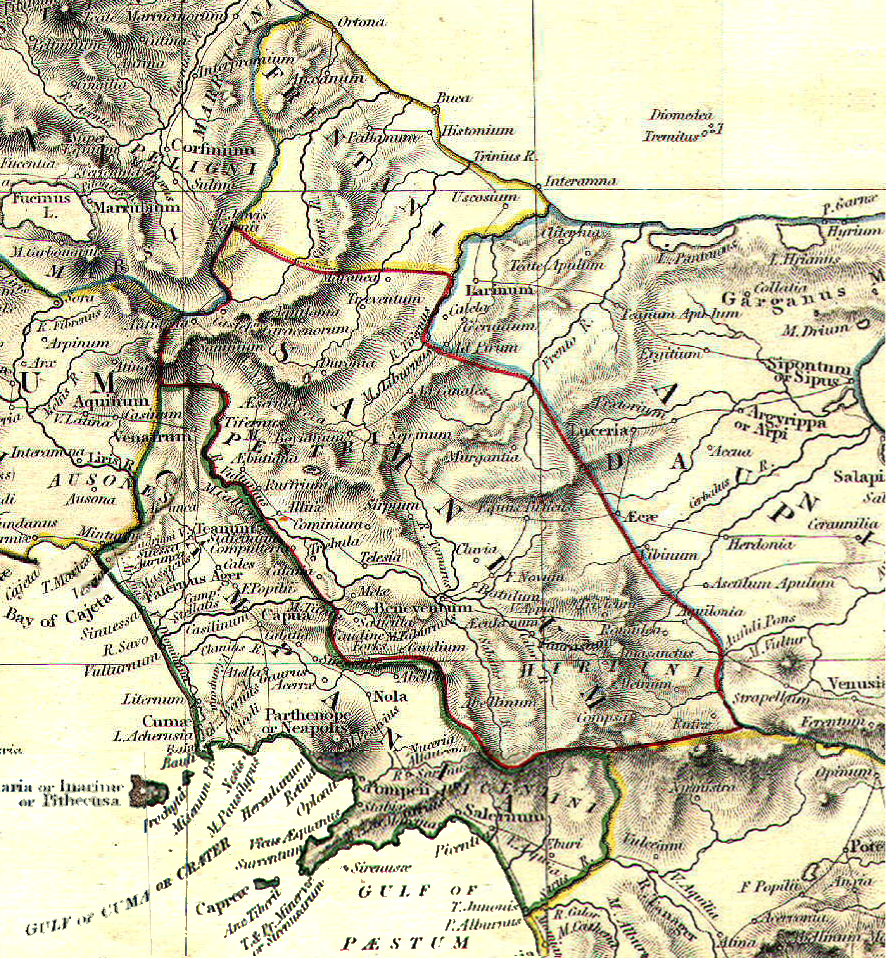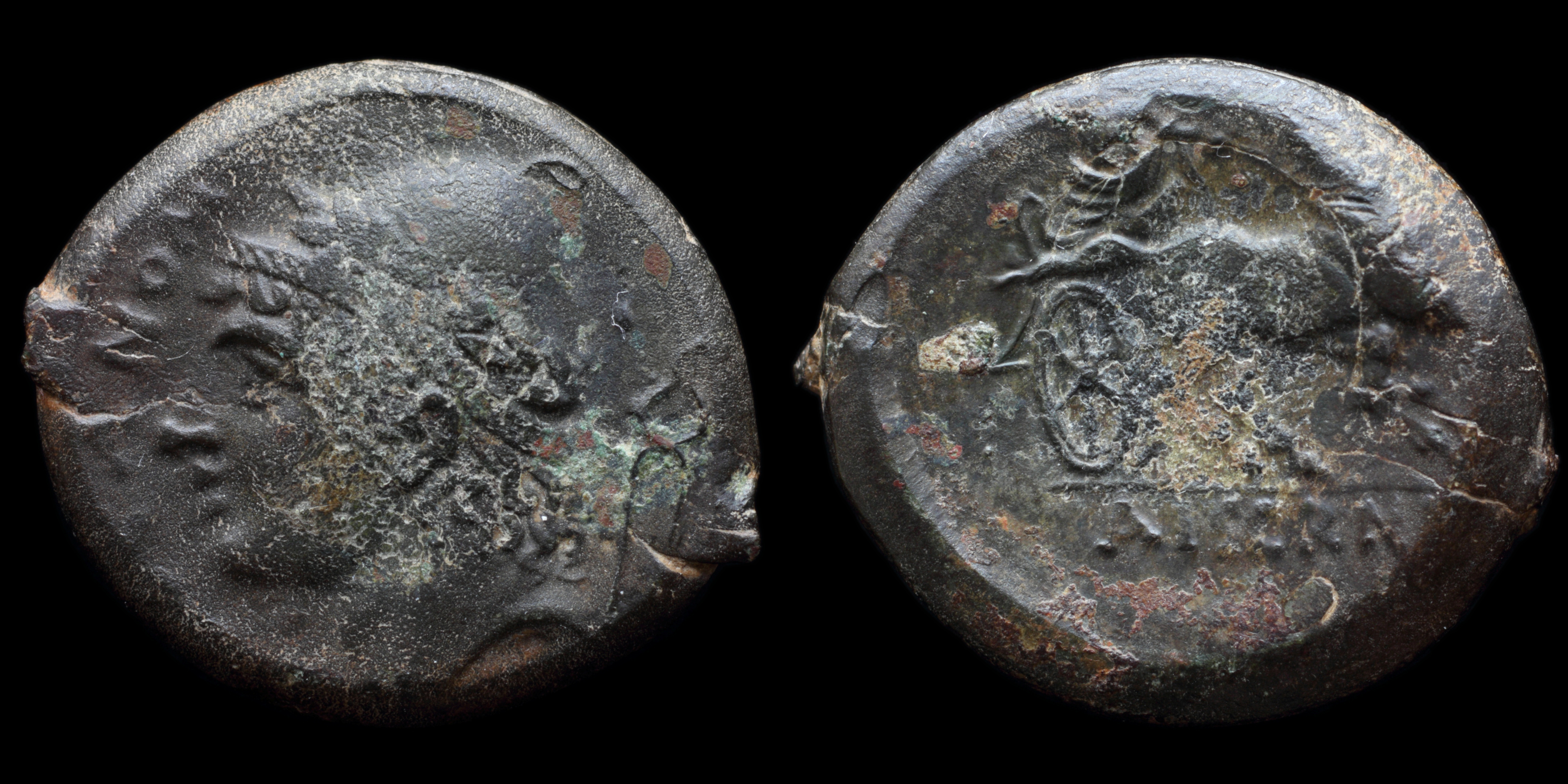Samnium is a Latin exonym for a region of Southern Italy inhabited by the Samnites. The ancient geographers were unable to relay a precise definition of Samnium's borders. Moreover, the areas it included vary depending on the time period considered.
Samnium mostly lay on the Apennine area; it was delimited by Latium to the north, by Lucania to the south, by Campania to the west, and by Apulia to the east. The principal cities of the region were Bovaiamom, renamed Bovianum by Latins and Maleventum (Maloenton in Oscan), which was later renamed Beneventum by the Romans. For most of their history the Samnites were landlocked, but during a brief period they controlled parts of both coasts of the Italian peninsula.
Samnium mostly lay on the Apennine area; it was delimited by Latium to the north, by Lucania to the south, by Campania to the west, and by Apulia to the east. The principal cities of the region were Bovaiamom, renamed Bovianum by Latins and Maleventum (Maloenton in Oscan), which was later renamed Beneventum by the Romans. For most of their history the Samnites were landlocked, but during a brief period they controlled parts of both coasts of the Italian peninsula.

(1)
Aesernia

Obverse: head of Vulcan left wearing laureate pileus, tongs behind; VOLCANOM
Reverse: Jupiter in biga right holding thunderbolt and reins; AISERNINO
Diameter:
20 mm
Die Orientation: -
Weight: 6.9 g
Die Orientation: -
Weight: 6.9 g
No notes for this coin
HNItaly 430 SNG Copenhagen 256-257 SNG ANS 118

Obverse: Laureate head of Italia left; VITELIV ( = ITALIA) retrograde in Oscan script behind.
Reverse: Soldier (or Mars?) standing facing, head right, left foot on lorica, holding inverted spear in right hand and sword in left; to right, recumbent bull facing, head left; I in exergue.
Diameter:
21 mm
Die Orientation: -
Weight: 3.75 g
Die Orientation: -
Weight: 3.75 g
"A new era of violence and conflict visited the Republic when in 91 B.C. Marcus Livius Drusus, a new Tribune with ideas much like the Gracchi brothers, acted as advocate for the urban and rural poor and the indigenous Italian peoples. Not only did he double the size of the senate by promoting 300 leading equites, but he tried to modify grain laws and to address old grievances over land distribution and eligibility for citizenship. Drusus' actions aroused such anger that he was murdered before his term had ended. It was the proverbial straw that broke the camel’s back, and the response among Rome’s Italian allies – who for decades had petitioned fruitlessly for improved status – was to break into revolt. The rebels comprised several Italian tribes, with the Marsi and the Samnites assuming leading roles in what came to be known as the Social War (91-87 B.C.). The capital of their breakaway state was Corfinium, where the rebels established a parallel system modeled on the institutions of the Republic, complete with a senate, consuls and praetors, and the prerogative to issue coins. After a faltering start, the Romans gained traction under the military leadership of Gaius Marius and Lucius Julius Caesar. None the less, the war was costly and destructive, and Caesar hoped hostilities would end when, in 90, he instituted the lex Iulia. The law granted full citizenship to Italian allies who were not actively engaged in making war on Rome. Though it represented progress, not every Italian insurgent was prepared to cease hostilities, and the war continued. Even with extraordinary generals such as Marius, Sulla and Gnaeus Pompey winning victories for the Republic, the war was so burdensome that leaders did not want to pursue it to the bitter end. Romans had been forced to raise more legions than at any time since the invasion of Hannibal, they struck more denarii in 90 than in any other year of the Republic, and from 89 to 87 silver was in such short supply that the purity of the denarius was reduced to slightly less than 95%. Perhaps the deciding factor, however, was a problem far from Italy: the Pontic King Mithradates VI was taking advantage of Rome’s distraction to expand his territories. In the darkest hour of the First Mithradatic War (89-85), Mithradates coordinated the murder in a single night of some 80,000 Romans in Asia Minor, and led an invasion of the province of Asia. With this tremendous concern, the Romans finally met the demands of the rebels for the complete enfranchisement of Italy – a promise that still required another eighteen years to fulfill. "
Provenance: Roma Numismatics Auction XVI (26 September 2018), lot 537. Ex Bolaffi Spa, Auction 29 (30 November 2016), lot 80.
Provenance: Roma Numismatics Auction XVI (26 September 2018), lot 537. Ex Bolaffi Spa, Auction 29 (30 November 2016), lot 80.
Campana group 9b, 141 (D97/R118).
